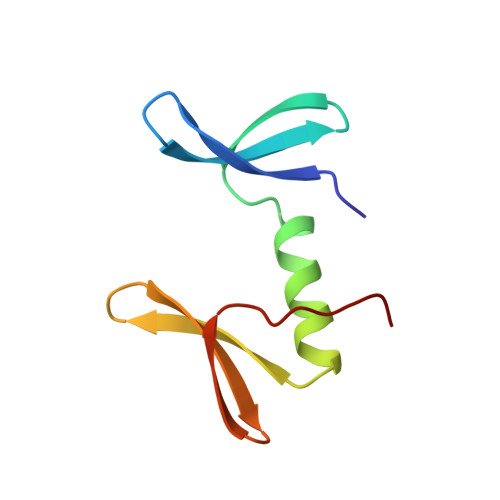Solution Structure and Ligand Recognition of the Ww Domain Pair of the Yeast Splicing Factor Prp40
Wiesner, S., Stier, G., Sattler, M., Macias, M.J.(2002) J Mol Biol 324: 807
- PubMed: 12460579
- DOI: https://doi.org/10.1016/s0022-2836(02)01145-2
- Primary Citation of Related Structures:
1O6W - PubMed Abstract:
The yeast splicing factor pre-mRNA processing protein 40 (Prp40) comprises two N-terminal WW domains, separated by a ten-residue linker, and six consecutive FF domains. In the spliceosome, the Prp40 WW domains participate in cross-intron bridging by interacting with proline-rich regions present in the branch-point binding protein (BBP) and the U5 small nuclear ribonucleoprotein component Prp8. Furthermore, binding of Prp40 to the phosphorylated C-terminal domain (CTD) of the largest subunit of RNA polymerase II is thought to link splicing to transcription. To gain insight into this complex interaction network we have determined the solution structure of the tandem Prp40 WW domains by NMR spectroscopy and performed chemical shift mapping experiments with different proline-rich peptides. The WW domains each adopt the characteristic triple-stranded beta-sheet structure and are connected by a stable alpha-helical linker. On the basis of a detailed analysis of residual dipolar couplings (RDC) and 15N relaxation data we show that the tandem Prp40 WW domains behave in solution as a single folded unit with unique alignment and diffusion tensor, respectively. Using [1H-15N]-RDCs, we were able to accurately define the relative orientation of the WW domains revealing that the binding pockets of each domain face opposite sides of the structure. Furthermore, we found that both Prp40 WW domains interact with PPxY motifs (where x is any residue) present in peptides derived from the splicing factors BBP and Prp8. Moreover, the Prp40 WW domains are shown to bind proline-rich peptides devoid of aromatic residues, which are also recognised by the Abl-SH3 domain and the WW domain of the mammalian Prp40 orthologue formin binding protein 11. In contrast, no interaction was observed between the Prp40 WW domains and the CTD repeats used in this work.
Organizational Affiliation:
Structural Biology Programme, EMBL Heidelberg, Meyerhofstr. 1, 69117 Heidelberg, Germany. weisner@nmr.embl-heidelberg.de














